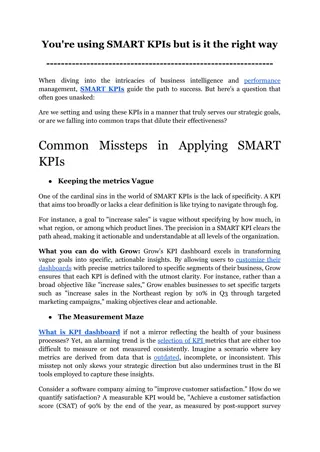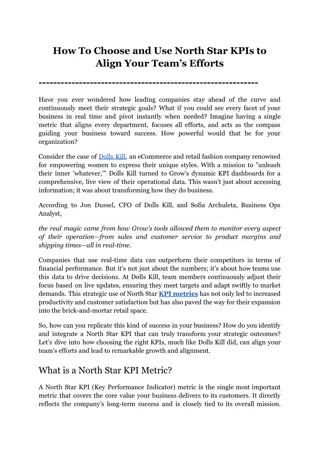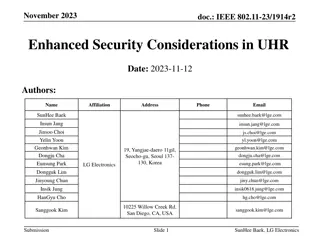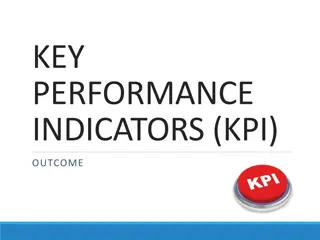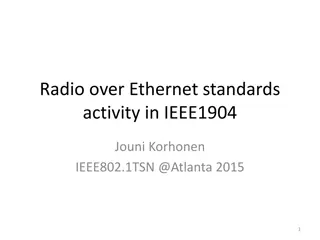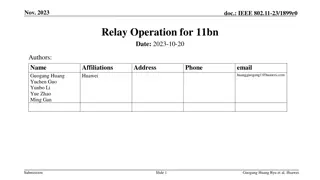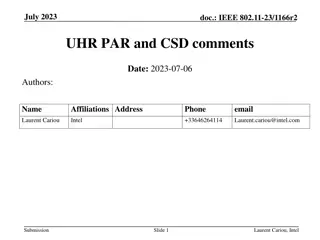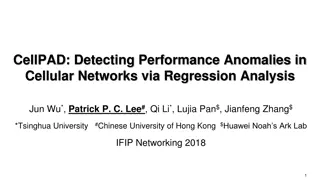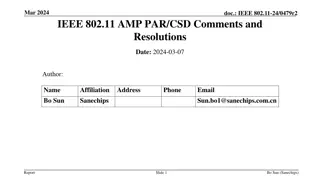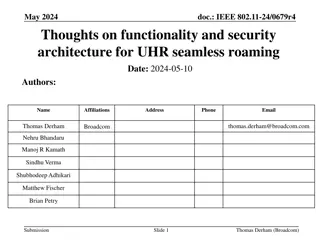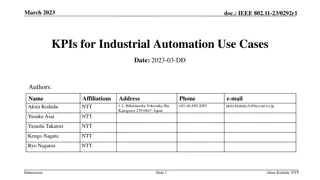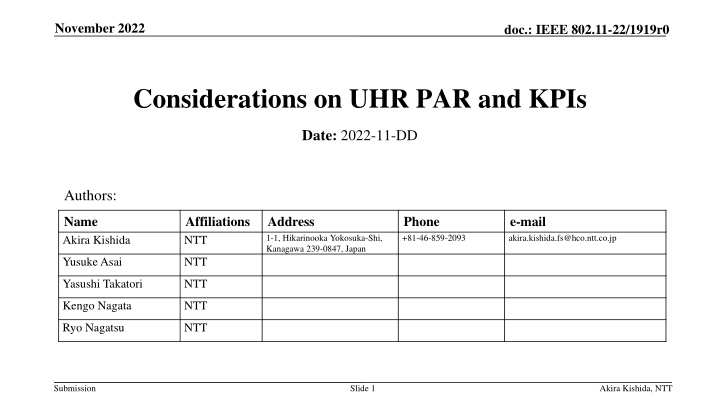
UHR PAR and KPIs Considerations
Various use cases proposed for UHR including metaverse, cloud VR, enterprise, business solutions, and home residential. Discussions on use cases and KPIs referenced related contributions, EHT PAR, and RTA TIG report to create PAR. EHT PAR defines modifications enabling high throughput and low latency for WLAN in evolving wireless data services landscape. New applications like virtual reality, gaming, and cloud computing drive the need for improved worst-case latency and jitter in UHR PAR.
Download Presentation

Please find below an Image/Link to download the presentation.
The content on the website is provided AS IS for your information and personal use only. It may not be sold, licensed, or shared on other websites without obtaining consent from the author. If you encounter any issues during the download, it is possible that the publisher has removed the file from their server.
You are allowed to download the files provided on this website for personal or commercial use, subject to the condition that they are used lawfully. All files are the property of their respective owners.
The content on the website is provided AS IS for your information and personal use only. It may not be sold, licensed, or shared on other websites without obtaining consent from the author.
E N D
Presentation Transcript
November 2022 doc.: IEEE 802.11-22/1919r0 Considerations on UHR PAR and KPIs Date: 2022-11-DD Authors: Name Akira Kishida Affiliations NTT Address 1-1, Hikarinooka Yokosuka-Shi, Kanagawa 239-0847, Japan Phone +81-46-859-2093 e-mail akira.kishida.fs@hco.ntt.co.jp Yusuke Asai NTT Yasushi Takatori NTT Kengo Nagata NTT Ryo Nagatsu NTT Submission Slide 1 Akira Kishida, NTT
November 2022 doc.: IEEE 802.11-22/1919r0 Introduction Various use cases, such as the metaverse, cloud VR[1][2], enterprise [3], business solutions [4], and home residential[5][6], are proposed for UHR. Though outlines of the PAR draft are proposed in previous UHR teleconferences[7][8], Use cases and KPIs should be discussed in UHR SG to create PAR. This contribution discusses use cases and KPIs by referring to related contributions[1-4], past EHT PAR[9], and the RTA TIG report[10]. RTA report consolidates key discussions of RTA TIG about some real-time application scenarios, problems with current Wi-Fi networks and requirements for future 802.11 standards. Submission Slide 2 Akira Kishida, NTT
November 2022 doc.: IEEE 802.11-22/1919r0 Use cases and KPIs for latency/jitter in EHT PAR [9] EHT PAR includes at least one feature that realizes improved worst case latency/jitter for the Scope of the project . The target values of those metrics are not clarified and defined. More specific use cases and KPIs are described in the Need for the Project of EHT PAR. New use cases discussed in UHR SG should be included in the Need for the Project of UHR PAR to expand the Wi-Fi market and clarify the advancement of UHR compared to EHT. Submission Slide 3 Akira Kishida, NTT
November 2022 doc.: IEEE 802.11-22/1919r0 EHT PAR [9] 5.2.b. Scope of the project: This amendment defines standardized modifications to both the IEEE Std. 802.11 physical layers (PHY) and Medium Access Control Layer (MAC) that enable at least one mode of operation capable of supporting a maximum throughput of at least 30 Gbps, as measured at the MAC data service access point (SAP), with carrier frequency operation between 1 and 7.250 GHz while ensuring backward compatibility and coexistence with legacy IEEE Std. 802.11 compliant devices operating in the 2.4 GHz, 5 GHz, and 6 GHz bands. This amendment defines at least one mode of operation capable of improved worst case latency and jitter. 5.5 Need for the Project: Wireless LAN (WLAN) continues its growth and is more and more important for providing wireless data services in many environments such as home, enterprise and hotspots. In particular video traffic will continue to be the dominant type of traffic in many WLAN deployments. The throughput requirements of these applications are in constant evolution due to the emergence of 4k and 8k video (uncompressed rate of 20 Gbps). New high-throughput, low latency applications will proliferate such as virtual reality or augmented reality, gaming, remote office and cloud computing (e.g., latency lower than 5ms for realtime gaming). Submission Slide 4 Akira Kishida, NTT
November 2022 doc.: IEEE 802.11-22/1919r0 Use cases and KPIs for UHR PAR (Metaverse/VR) Contributions [1][2] introduce use cases of the metaverse, AR/VR, and cloud VR in detail. These will be significant use cases for the Wi-Fi market. Therefore, including those use cases for the Need for the Project of UHR PAR should be considered. Latency/jitter requirements are essential KPIs in those use cases. Less than 20 msec Motion- to-Photon (MTP) latency may be required, and some trained/skillful users may require less than 7-15 msec for an immersive experience of the metaverse. Less than 10 msec of home WLAN latency will be required for a fair-experience phase in cloud VR. Submission Slide 5 Akira Kishida, NTT
November 2022 doc.: IEEE 802.11-22/1919r0 Use cases for UHR PAR (Enterprise/Business) Contributions [3][4] introduce use cases for enterprises and business use cases such as industrial IoT (IIoT), logistics, and smart agriculture, respectively. These are significant use cases for the Wi-Fi market as well, and including those use cases for the Need for the Project of UHR PAR should also be considered. Latency/jitter requirements are also essential KPIs in those use cases. Examples of Wi-Fi business use cases Industrial IoT Logistics Smart Agriculture Submission Slide 6 Akira Kishida, NTT
November 2022 doc.: IEEE 802.11-22/1919r0 Consideration of KPIs for Wi-Fi business use cases Use cases Intra BSS latency [ms] Jitter variance [ms] Packet loss Data rate [Mbps] RTA TIG was a Topic Interest Group that investigated real- time applications that require low latency and summarized their activities in the RTA report[10]. Wi-Fi business use cases introduced in [4] consist of multiple use cases analyzed in the RTA report [10]. Real-time gaming < 5 < 2 < 0.1 % < 1 Cloud gaming < 10 < 2 Near- lossless < 0.1 (Reverse link) > 5Mbps (Forward link) Real-time video < 3 ~ 10 < 1~ 2.5 Near- lossless 100 ~ 28,000 Robotics and industrial automation Equipment control < 1 ~ 10 < 0.2~2 Near- lossless < 1 Human safety < 1 ~ 10 < 0.2 ~ 2 Near- lossless < 1 Haptic technology < 1 ~ 5 <0.2~2 Lossless <1 Drone control < 100 <10 Lossless <1 >100 with video These requirements are correspond to use cases introduced in a previous slide Requirements of each use case (from RTA report) Submission Slide 7 Akira Kishida, NTT
November 2022 doc.: IEEE 802.11-22/1919r0 Consideration on use cases and KPIs in UHR PAR Use cases introduced in previous slides will be significant for UHR. Latency/jitter should be essential KPIs for UHR. The target value of those KPIs should be defined to fulfill the requirements of latency/jitter-sensitive use cases in the Scope of the project in UHR PAR. The target value is considered to be a further discussion item. Submission Slide 8 Akira Kishida, NTT
November 2022 doc.: IEEE 802.11-22/1919r0 Summary We discussed use cases and KPIs that UHR PAR should include for the Need for the Project and the Scope of the project, respectively. The Need for the Project of UHR PAR should include Latency/jitter-sensitive use cases. The target value of latency/jitter should be defined in the Scope of the project of UHR PAR. The target value is considered to be a further discussion item. Submission Slide 9 Akira Kishida, NTT
November 2022 doc.: IEEE 802.11-22/1919r0 SP 1 Do you agree that the Need for the Project of UHR PAR also includes use cases of the latency/jitter-sensitive applications such as metaverse, cloud AR/VR, enterprise, industrial IoT (IIoT), logistics, and smart agriculture? -Yes -No -Need More Discussion -Abstain Submission Slide 10 Akira Kishida, NTT
November 2022 doc.: IEEE 802.11-22/1919r0 SP 2 Do you agree that the target value of latency bound and jitter variance should be defined in the Scope of the project of UHR PAR? Note: the target value is considered a further discussion item. -Yes -No -Need More Discussion -Abstain Submission Slide 11 Akira Kishida, NTT
November 2022 doc.: IEEE 802.11-22/1919r0 References [1] Chunyu Hu, 802.11bx: Enabling Metaverse -- Metaverse, AR/VR, and Wearables, IEEE 802.11-22/0779r0 [2] Ross Jian Yu, et al., Cloud VR Use Case and Requirements, IEEE 802.11-22/0952r0 [3] Brian Hart, et al., A perspective on proposed Ultra-High Reliability (UHR) features for enterprise use cases, IEEE 802.11-22/1280r1 [4] Akira Kishida, et al., Use Cases for Wi-Fi Business Solutions in UHR, IEEE 802.11- 22/1493r1 [5] James Yee, et al., Multi AP Coordination and Residential Wi-Fi, IEEE 802.11-22/1512r0 [6] Amelia Andersdotter, et al., Ultra-High Reliability (UHR) requirements for home- networking use cases, IEEE 802.11-22/1790r0 [7] Ming Gan, et al., 802.11 UHR SG Proposed PAR, IEEE 802.11-22/1518r0 [8] Tuncer Baykas, et al., Project Authorization Request Proposal for 802.11 UHR SG, IEEE 802.11-22/1750r0 [9] Laurent Cariou, 802.11 EHT Proposed PAR, IEEE 802.11-18/1231r6 [10] Kate Meng, et al., RTA report draft, IEEE 802.11-18/2009r6 [11] Osama Aboul-Magd, 802.11 HEW SG Proposed PAR, IEEE 802.11-14/0165r1 Submission Slide 12 Akira Kishida, NTT
November 2022 doc.: IEEE 802.11-22/1919r0 Backup Submission Slide 13 Akira Kishida, NTT
November 2022 doc.: IEEE 802.11-22/1919r0 PAR description for the limited situation in 11ax (HEW) [11] 5.2.b. Scope of the project: This amendment defines standardized modifications to both the IEEE 802.11 physical layers (PHY) and the IEEE 802.11 Medium Access Control layer (MAC) that enable at least one mode of operation capable of supporting at least four times improvement in the average throughput per station (measured at the MAC data service access point) in a dense deployment scenario, while maintaining or improving the power efficiency per station. As The HEW PAR (11ax)[11] describes above, the Scope of the project is expressed in a limited situation, such as "four times improvement in the average throughput per station in a dense deployment scenario. We can describe the Scope of the project of UHR PAR in the same manner as HEW PAR. Namely, concrete values of latency bound and jitter varience in the case of managed networks are recommended to be defined. Submission Slide 14 Akira Kishida, NTT

